


15 Key Sales Reports in HubSpot for Effective Sales Analysis



Imagine trying to steer your team without knowing where you've been or where you're heading – that's what managing sales without proper reporting feels like. Clear and actionable insights are essential to drive your team's success, and that's where effective sales reports come into play.
As a sales leader, mastering HubSpot's sales reporting tools can significantly enhance your ability to make informed decisions. This blog will walk you through everything you need to know about building powerful sales reports in HubSpot. From setting up your initial reports to diving into advanced analytics, let's get you equipped with the knowledge and tools to turn your sales data into meaningful insights.
Building Sales Reports in HubSpot
Sales teams thrive when they have access to precise and actionable data. The right sales reports can provide insights into every stage of the sales process, from lead generation to closing deals. Here are the key sales reports you need for maximising your team's performance:
A. Pipeline and Activity Metrics
- Pipeline Generation by Rep and Segment
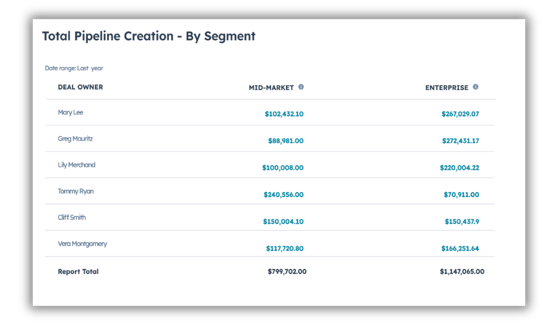
This sales report tracks pipeline creation by individual sales reps and market segments. By identifying who is generating the most opportunities and in which segments, you can tailor your training and support efforts to boost overall performance. Additionally, tracking leads with high intent (e.g., web visits) but no set task/meeting ensures that potential opportunities are not slipping through the cracks, enabling more efficient pipeline generation. - Activity by Rep
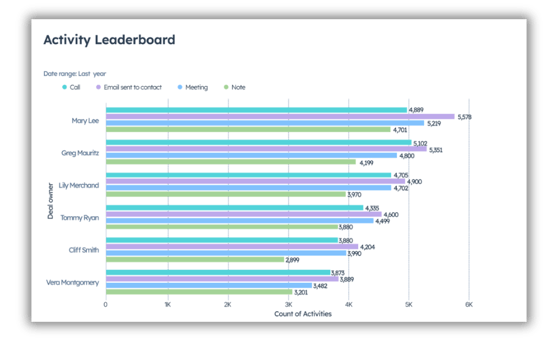
Monitoring the activities performed by each sales representative, such as calls, emails, and meetings, helps you understand their productivity levels. This report can highlight areas where additional coaching might be needed to enhance efficiency. To further enhance this, tracking SQLs with no logged action ensures that qualified leads are consistently engaged and moved through the pipeline. - Meetings Booked by Rep
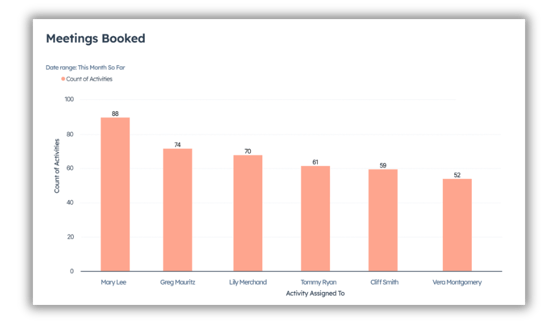
Tracking the number of meetings scheduled by each sales rep provides insight into their engagement levels with prospects. High numbers of booked meetings often indicate a proactive approach to nurturing leads. Furthermore, deals with no set meetings in the future can be identified to mitigate risks in the sales pipeline and ensure continuous engagement with prospects. - Call Outcome by Rep

Evaluating the outcomes of calls made by sales reps allows you to identify patterns in successful and unsuccessful interactions. This sales report can help you refine your call strategies and training programs. Additionally, deals at later stages with undercooked qualification can be surfaced to address potential risks early and improve the chances of closing deals.
B. Deal Analysis
- Closed Won Reasons (On Avg. Broken Down by Deal Value)
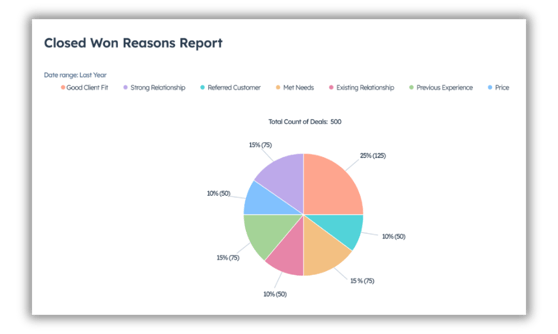
Analysing reasons for successfully closed deals, segmented by deal value, helps you understand what factors contribute to winning deals. This insight can inform your sales strategies and lead prioritisation. - Closed Lost Reasons (On Avg. Broken Down by Deal Value)
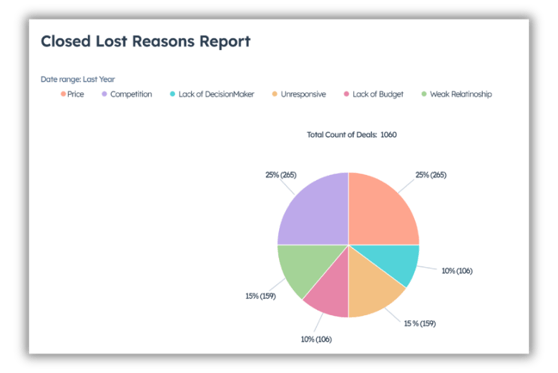
Understanding why deals are lost, categorised by deal value, enables you to address common objections and improve your pitch. This report is crucial for refining your sales process and increasing your win rate. - Average Number of Stakeholders Involved (Broken Down by Deal Value)

Measuring the number of decision-makers involved in deals of varying values helps you strategise your approach. More stakeholders often mean longer sales cycles, so knowing this can aid in resource allocation and expectation management. - Persona Types Involved

Identifying the types of personas engaged in the sales process allows you to tailor your messaging and approach. This sales report ensures that your sales pitches resonate with the right people at the right time.
C. Conversion and Qualification Metrics
- Deal Conversion Rate

Measuring the percentage of deals that convert at each stage provides a clear picture of your sales funnel health. High conversion rates indicate a strong process, while low rates may highlight areas needing improvement. - Qualification Score
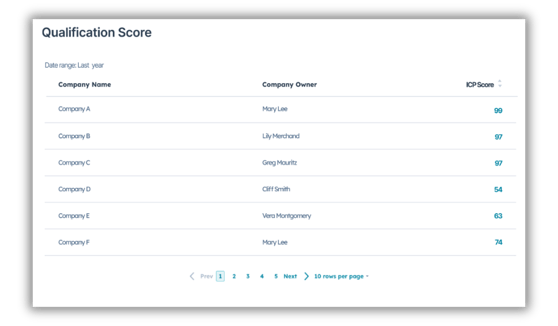
Assessing the qualification score of leads helps prioritise efforts on the most promising prospects. This metric ensures that your team focuses on leads that are most likely to convert. - Product Fit Score
Measuring how well a product fits the needs of potential customers can guide your sales pitches and demo strategies. A high product fit score often correlates with higher chances of closing deals. - Metrics Fit Score
Evaluating leads based on key metrics ensures that your sales efforts are aligned with business goals. This score helps in qualifying leads more effectively. - Deal Relationship Score
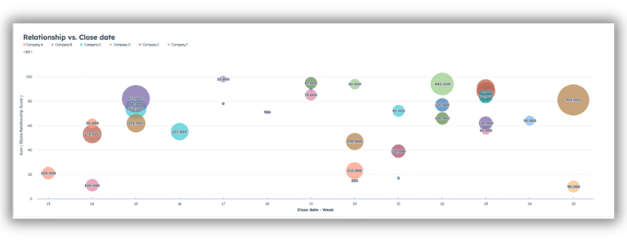
Assessing the strength of relationships in deals provides insight into trust and rapport with clients. Strong relationships often lead to easier negotiations and better deal outcomes. - Company Relationship Score
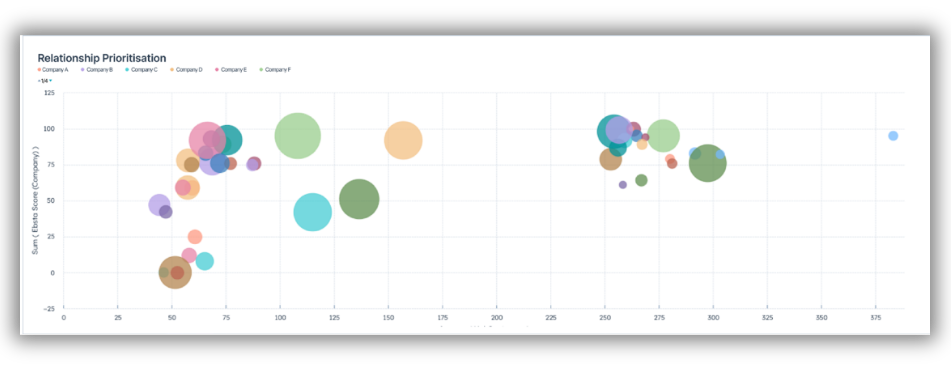
Measuring the overall relationship strength with the company helps you understand your standing and influence within client organisations. It’s essential for long-term business development and upsell opportunities. - Average Sales Cycle per Sales Rep
Tracking the average duration of the sales cycle for each rep offers insights into their efficiency and effectiveness. Shorter sales cycles typically indicate a more streamlined and effective sales process.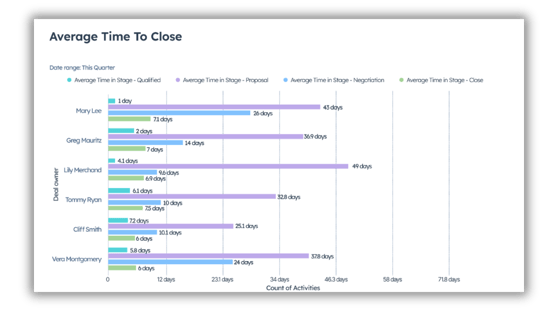
Centralising these sales reports on a dashboard ensures that your sales team has easy access to actionable insights, reducing the time spent on data analysis and freeing up resources to focus on strategic initiatives. With the right HubSpot sales reporting tools, you can simplify the reporting process and ensure you’re always on top of your metrics.
Overview of HubSpot Sales Reporting Tools
HubSpot is a comprehensive CRM platform designed to streamline your sales processes and enhance your team's productivity. It offers a suite of tools to manage and analyse your sales data effectively, making it easier for you to stay on top of your game.
Sales Reporting Features in HubSpot
HubSpot provides a range of powerful sales reporting features, including:
- Customisable Dashboards: Create dashboards tailored to your specific needs, offering a real-time view of your key sales metrics.
- Pre-Built Reports: Access a variety of pre-built reports that cover common sales scenarios, saving you time and effort.
- Report Builder: Build custom reports from scratch using HubSpot's intuitive report builder, allowing you to focus on the metrics that matter most to your business.
- Sales Analytics Tools: Dive deep into your sales data with advanced analytics tools that help you understand performance trends and identify growth opportunities.
- Automated Reports: Schedule reports to be generated and sent to your inbox automatically, ensuring you always have the latest data at your fingertips.
Benefits of Using HubSpot for Sales Reporting
- Centralised Data: All your sales data is stored in one place, making it easy to access and analyse.
- User-Friendly Interface: HubSpot's intuitive interface ensures that even non-technical users can create and interpret sales reports with ease.
- Real-Time Insights: Get up-to-the-minute data on your sales performance, enabling you to make timely decisions.
- Scalability: Whether you're a small business or a large enterprise, HubSpot's flexible reporting tools can scale to meet your needs.
Effective sales reporting is the backbone of any successful sales strategy. As a sales leader, leveraging HubSpot’s powerful reporting tools can transform raw data into actionable insights, driving smarter decisions and improved performance.
Remember, the true power of sales data lies not just in collecting it but in analysing and interpreting it to uncover valuable trends and opportunities.








